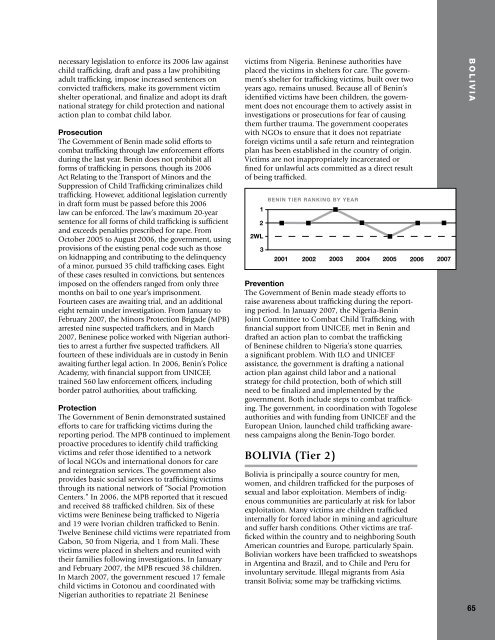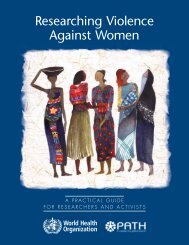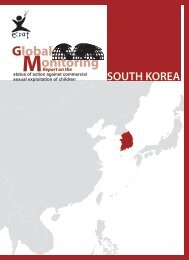2007 Trafficking in Persons Report - Center for Women Policy Studies
2007 Trafficking in Persons Report - Center for Women Policy Studies
2007 Trafficking in Persons Report - Center for Women Policy Studies
Create successful ePaper yourself
Turn your PDF publications into a flip-book with our unique Google optimized e-Paper software.
necessary legislation to en<strong>for</strong>ce its 2006 law aga<strong>in</strong>st<br />
child traffick<strong>in</strong>g, draft and pass a law prohibit<strong>in</strong>g<br />
adult traffick<strong>in</strong>g, impose <strong>in</strong>creased sentences on<br />
convicted traffickers, make its government victim<br />
shelter operational, and f<strong>in</strong>alize and adopt its draft<br />
national strategy <strong>for</strong> child protection and national<br />
action plan to combat child labor.<br />
Prosecution<br />
The Government of Ben<strong>in</strong> made solid ef<strong>for</strong>ts to<br />
combat traffick<strong>in</strong>g through law en<strong>for</strong>cement ef<strong>for</strong>ts<br />
dur<strong>in</strong>g the last year. Ben<strong>in</strong> does not prohibit all<br />
<strong>for</strong>ms of traffick<strong>in</strong>g <strong>in</strong> persons, though its 2006<br />
Act Relat<strong>in</strong>g to the Transport of M<strong>in</strong>ors and the<br />
Suppression of Child <strong>Traffick<strong>in</strong>g</strong> crim<strong>in</strong>alizes child<br />
traffick<strong>in</strong>g. However, additional legislation currently<br />
<strong>in</strong> draft <strong>for</strong>m must be passed be<strong>for</strong>e this 2006<br />
law can be en<strong>for</strong>ced. The law’s maximum 20-year<br />
sentence <strong>for</strong> all <strong>for</strong>ms of child traffick<strong>in</strong>g is sufficient<br />
and exceeds penalties prescribed <strong>for</strong> rape. From<br />
October 2005 to August 2006, the government, us<strong>in</strong>g<br />
provisions of the exist<strong>in</strong>g penal code such as those<br />
on kidnapp<strong>in</strong>g and contribut<strong>in</strong>g to the del<strong>in</strong>quency<br />
of a m<strong>in</strong>or, pursued 35 child traffick<strong>in</strong>g cases. Eight<br />
of these cases resulted <strong>in</strong> convictions, but sentences<br />
imposed on the offenders ranged from only three<br />
months on bail to one year’s imprisonment.<br />
Fourteen cases are await<strong>in</strong>g trial, and an additional<br />
eight rema<strong>in</strong> under <strong>in</strong>vestigation. From January to<br />
February <strong>2007</strong>, the M<strong>in</strong>ors Protection Brigade (MPB)<br />
arrested n<strong>in</strong>e suspected traffickers, and <strong>in</strong> March<br />
<strong>2007</strong>, Ben<strong>in</strong>ese police worked with Nigerian authorities<br />
to arrest a further five suspected traffickers. All<br />
fourteen of these <strong>in</strong>dividuals are <strong>in</strong> custody <strong>in</strong> Ben<strong>in</strong><br />
await<strong>in</strong>g further legal action. In 2006, Ben<strong>in</strong>’s Police<br />
Academy, with f<strong>in</strong>ancial support from UNICEF,<br />
tra<strong>in</strong>ed 560 law en<strong>for</strong>cement officers, <strong>in</strong>clud<strong>in</strong>g<br />
border patrol authorities, about traffick<strong>in</strong>g.<br />
Protection<br />
The Government of Ben<strong>in</strong> demonstrated susta<strong>in</strong>ed<br />
ef<strong>for</strong>ts to care <strong>for</strong> traffick<strong>in</strong>g victims dur<strong>in</strong>g the<br />
report<strong>in</strong>g period. The MPB cont<strong>in</strong>ued to implement<br />
proactive procedures to identify child traffick<strong>in</strong>g<br />
victims and refer those identified to a network<br />
of local NGOs and <strong>in</strong>ternational donors <strong>for</strong> care<br />
and re<strong>in</strong>tegration services. The government also<br />
provides basic social services to traffick<strong>in</strong>g victims<br />
through its national network of “Social Promotion<br />
<strong>Center</strong>s.” In 2006, the MPB reported that it rescued<br />
and received 88 trafficked children. Six of these<br />
victims were Ben<strong>in</strong>ese be<strong>in</strong>g trafficked to Nigeria<br />
and 19 were Ivorian children trafficked to Ben<strong>in</strong>.<br />
Twelve Ben<strong>in</strong>ese child victims were repatriated from<br />
Gabon, 50 from Nigeria, and 1 from Mali. These<br />
victims were placed <strong>in</strong> shelters and reunited with<br />
their families follow<strong>in</strong>g <strong>in</strong>vestigations. In January<br />
and February <strong>2007</strong>, the MPB rescued 38 children.<br />
In March <strong>2007</strong>, the government rescued 17 female<br />
child victims <strong>in</strong> Cotonou and coord<strong>in</strong>ated with<br />
Nigerian authorities to repatriate 21 Ben<strong>in</strong>ese<br />
victims from Nigeria. Ben<strong>in</strong>ese authorities have<br />
placed the victims <strong>in</strong> shelters <strong>for</strong> care. The government’s<br />
shelter <strong>for</strong> traffick<strong>in</strong>g victims, built over two<br />
years ago, rema<strong>in</strong>s unused. Because all of Ben<strong>in</strong>’s<br />
identified victims have been children, the government<br />
does not encourage them to actively assist <strong>in</strong><br />
<strong>in</strong>vestigations or prosecutions <strong>for</strong> fear of caus<strong>in</strong>g<br />
them further trauma. The government cooperates<br />
with NGOs to ensure that it does not repatriate<br />
<strong>for</strong>eign victims until a safe return and re<strong>in</strong>tegration<br />
plan has been established <strong>in</strong> the country of orig<strong>in</strong>.<br />
Victims are not <strong>in</strong>appropriately <strong>in</strong>carcerated or<br />
f<strong>in</strong>ed <strong>for</strong> unlawful acts committed as a direct result<br />
of be<strong>in</strong>g trafficked.<br />
Prevention<br />
The Government of Ben<strong>in</strong> made steady ef<strong>for</strong>ts to<br />
raise awareness about traffick<strong>in</strong>g dur<strong>in</strong>g the report<strong>in</strong>g<br />
period. In January <strong>2007</strong>, the Nigeria-Ben<strong>in</strong><br />
Jo<strong>in</strong>t Committee to Combat Child <strong>Traffick<strong>in</strong>g</strong>, with<br />
f<strong>in</strong>ancial support from UNICEF, met <strong>in</strong> Ben<strong>in</strong> and<br />
drafted an action plan to combat the traffick<strong>in</strong>g<br />
of Ben<strong>in</strong>ese children to Nigeria’s stone quarries,<br />
a significant problem. With ILO and UNICEF<br />
assistance, the government is draft<strong>in</strong>g a national<br />
action plan aga<strong>in</strong>st child labor and a national<br />
strategy <strong>for</strong> child protection, both of which still<br />
need to be f<strong>in</strong>alized and implemented by the<br />
government. Both <strong>in</strong>clude steps to combat traffick<strong>in</strong>g.<br />
The government, <strong>in</strong> coord<strong>in</strong>ation with Togolese<br />
authorities and with fund<strong>in</strong>g from UNICEF and the<br />
European Union, launched child traffick<strong>in</strong>g awareness<br />
campaigns along the Ben<strong>in</strong>-Togo border.<br />
BOLIVIA (Tier 2)<br />
Bolivia is pr<strong>in</strong>cipally a source country <strong>for</strong> men,<br />
women, and children trafficked <strong>for</strong> the purposes of<br />
sexual and labor exploitation. Members of <strong>in</strong>digenous<br />
communities are particularly at risk <strong>for</strong> labor<br />
exploitation. Many victims are children trafficked<br />
<strong>in</strong>ternally <strong>for</strong> <strong>for</strong>ced labor <strong>in</strong> m<strong>in</strong><strong>in</strong>g and agriculture<br />
and suffer harsh conditions. Other victims are trafficked<br />
with<strong>in</strong> the country and to neighbor<strong>in</strong>g South<br />
American countries and Europe, particularly Spa<strong>in</strong>.<br />
Bolivian workers have been trafficked to sweatshops<br />
<strong>in</strong> Argent<strong>in</strong>a and Brazil, and to Chile and Peru <strong>for</strong><br />
<strong>in</strong>voluntary servitude. Illegal migrants from Asia<br />
transit Bolivia; some may be traffick<strong>in</strong>g victims.<br />
B O L I V I A<br />
65
















